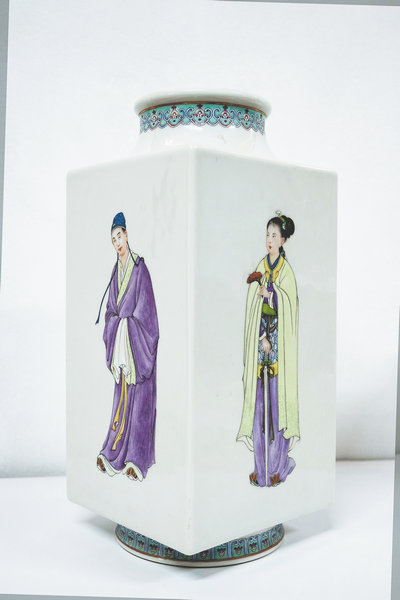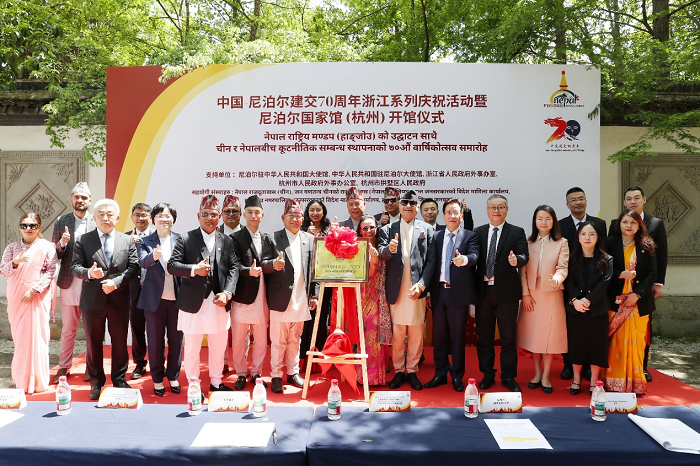Vase offers a glimpse of intrigue

A porcelain vase created in 1954 by Wang Xiliang (1922-2023) features four main characters of The Legend of the White Snake. [Photo/CHINA DAILY]
Chinese artwork in Bulgaria, with intricate decorations, suggests creative genius and a capacity to forge connections across borders, Yang Feiyue reports.
Lian Mian has seen his fair share of porcelain. Yet, when the art history professor from the China Academy of Art in Hangzhou, East China's Zhejiang province, stepped into the quiet halls of the Regional Ethnographic Museum of Plovdiv, Bulgaria, in 2023, a Chinese porcelain vase dating back to 1954 caught him off guard.
It left him with the feeling that he had stumbled upon something truly unique.
"I was invited there for Dragon Boat Festival that year, and then the museum director, Angel Yankov, showed me their Chinese collection. That's when I first encountered this piece," he recalls.
As Lian looked deeper, what truly stunned him was not just its beauty but the fact that it might be one of the first known Chinese export porcelain items from the 1950s found in Eastern Europe.
The porcelain vessel struck him with its distinctive form: a square body supporting a circular mouth, rising on a ring foot, with a hollow rectangular cuboid frame.
"It symbolizes the Chinese philosophical concept of 'heaven is round, and the earth is square'," Lian says.
This geometric harmony was just the beginning. The vase's rim is adorned with a fine band of interlocking motifs — wisps of auspicious clouds, plump pomegranates and bats.
Each element, Lian notes, was carefully chosen to invoke blessings of prosperity, abundance and fertility within traditional Chinese decorative practice.
The four corners and Buddhist-yellow square borderlines are embellished with lotus-cloud-like motifs, adding to its intricacy. The lower foot features a continuous design of deformed cicadas and lotus flowers, while three golden bands wrap around the mouth and base.
These detailed components embody the aesthetic essence of Qing Dynasty (1644-1911) porcelain, echoed in the craftsmanship that continued in Jingdezhen, the renowned porcelain capital in East China's Jiangxi province.
"These all represent a typical style imitating the Qing Dynasty (elements) that has continued to be produced in Jingdezhen," Lian notes.
To Lian, these details not only signal a tribute to tradition but also reveal the genius of its creator, Wang Xiliang (1922-2023), a man who bridged imperial-era artistry and innovation in modern period.
Born into a family of master artisans in Jingdezhen, Wang inherited the mastery of traditional blue-and-white techniques. Yet, he was not content to simply follow in his ancestors' footsteps. Instead, he pushed the boundaries of porcelain painting by revolutionizing the overglaze enamel technique.
"Wang committed himself to elevating porcelain painting beyond tradition, and this Bulgarian-held masterpiece shows his early brilliance," Lian says. Further insights from labels on the vase and explanations provided by the museum staff suggest that the vase may have been part of international exhibitions held across Eastern Europe.
"The 1950s was a key period in Wang Xiliang's artistic development and transformation, during which he participated in the 'Jianguo Porcelain' project led by the China National Light Industry Council," Lian says.
The Jianguo ("founding of New China") Porcelain movement played a foundational role in revitalizing the ceramic industry in the years following the founding of the People's Republic of China in 1949.
The initiative spearheaded the recovery of major kiln sites, such as those in Jingdezhen, and aimed to reclaim China's global reputation in porcelain art.
Preceding this national campaign were the Export Exhibition Porcelains, which embodied China's early efforts to initiate a cultural renaissance on the world stage through art and diplomacy.
"This vase may be the first identified example of Export Exhibition Porcelains in Central and Eastern Europe, which was a tangible witness to cultural diplomacy among the socialist countries," Lian says.
These export pieces were deliberately dispersed globally, making intact discoveries exceptionally rare, he emphasizes.
It was during this transformative period that Wang began experimenting with new techniques in sketching, coloring, and life drawing, often guided by seasoned artists of the era. He merged traditional Chinese themes with contemporary forms, drawing on observational sketching to produce works rich in emotion and visual dynamism.
One such work, a plate titled Picking Tea and Catching Butterflies, was selected for exhibition in Eastern Europe in 1954, according to the Wang Xiliang Chronology. Archival records show that this piece was among a batch chosen for a touring exhibition organized by the Ministry of Culture and Tourism and the Beijing-based Central Academy of Fine Arts.
"This porcelain vase may well be one of those pieces," Lian says.
Beyond its cultural and historical implications, the vase also stands as a narrative and visual triumph. It breathes new life into Chinese folktale The Legend of the White Snake, transforming it into a four-panel pictorial epic that seamlessly blends classical artistry with modern storytelling.
The legend recounts the tale of Bai Suzhen, a benevolent snake spirit who transforms into a woman to repay a debt of gratitude to a mortal, Xu Xian.
Their love blossoms into marriage, but they are later torn apart by the zealous monk Fa Hai, who exposes Bai's supernatural identity and imprisons her beneath the Leifeng Pagoda. Her loyal maidservant, Xiaoqing — a green snake spirit — and later their son seek to free her.
Popularized through operas during the Ming (1368-1644) and Qing dynasties, it remains a timeless allegory.
Wang rendered each character with exquisite detail and symbolic meaning.
The bearded monk Fa Hai dominates the composition, wearing a five-Buddha crown and a crimson monastic robe fastened with circular knot buttons over a yellow undergarment, exuding stern doctrinal authority.
Wang's brush captures the character's dogmatism through facial rigor, which highlights thunderous brows and eyes brimming with righteous fury, Lian notes.
Bai Suzhen appears with her right hand resting on a sword. Her defiant stance is emphasized through her jade-green cloak and cloud-collar drapes, layered over a tortoiseshell-patterned warrior sash — a fusion that implies both grace and combatreadiness.
Her maidservant, Xiaoqing, dressed in azure, is a symbol of purity and rebellion. She is depicted midmotion, wielding a back-slung sword with red ribbons trailing across her yellow-trimmed robes.
"It is noteworthy that Wang incorporated his physical traits into the portrayal of Xu Xian, adding a special touch of the artist's presence to the traditional iconography," Lian observes.
The vase entered the museum's collection sometime after 1965. While its exact path remains unclear, scholars believe it likely traveled as part of a touring exhibition or was presented as a diplomatic gift to Bulgaria and the city of Plovdiv during the wave of cultural exchanges among socialist nations after World War II.
"The vase's provenance demonstrates the international recognition of Wang's artistry and offers valuable insight into the cultural exchanges in the mid-20th century," Lian adds.
Lian's further research also led him to related collections at Sofia's National Gallery in Bulgaria, where he found works by other prominent Chinese artists such as He Xiangning (1878-1972) and Xu Beihong (1895-1953).
They all suggested a robust web of cultural diplomacy, Lian says.
Contact the writer at [email protected]
-
Inside Hangzhou: China's high-tech dream factory
March 12, 2025



